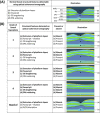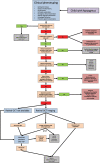Management of nystagmus in children: a review of the literature and current practice in UK specialist services
- PMID: 31919431
- PMCID: PMC7608566
- DOI: 10.1038/s41433-019-0741-3
Management of nystagmus in children: a review of the literature and current practice in UK specialist services
Erratum in
-
Correction: Management of nystagmus in children: a review of the literature and current practice in UK specialist services.Eye (Lond). 2020 Sep;34(9):1717. doi: 10.1038/s41433-020-0797-0. Eye (Lond). 2020. PMID: 32467640 Free PMC article.
Abstract
Nystagmus is an eye movement disorder characterised by abnormal, involuntary rhythmic oscillations of one or both eyes, initiated by a slow phase. It is not uncommon in the UK and regularly seen in paediatric ophthalmology and adult general/strabismus clinics. In some cases, it occurs in isolation, and in others, it occurs as part of a multisystem disorder, severe visual impairment or neurological disorder. Similarly, in some cases, visual acuity can be normal and in others can be severely degraded. Furthermore, the impact on vision goes well beyond static acuity alone, is rarely measured and may vary on a minute-to-minute, day-to-day or month-to-month basis. For these reasons, management of children with nystagmus in the UK is varied, and patients report hugely different experiences and investigations. In this review, we hope to shine a light on the current management of children with nystagmus across five specialist centres in the UK in order to present, for the first time, a consensus on investigation and clinical management.
摘要: 眼球震颤是一种眼球运动障碍以单眼或双眼异常的、不自主的节律性摆动为特征, 其发病缓慢。在英国的发病率不低, 通常就诊于小儿眼科和成人普通/斜视门诊。眼球震颤在某些情况下单发, 也可伴发多系统疾病、严重视力损害或神经系统疾病。同样, 在一些病例中, 患者视力正常, 另一些病例中, 患者视力严重下降。而且其对视力的影响远超过对静态视敏度的影响, 几乎检测不到, 而且可能在每分钟、每天或每月的基础上不断变化。基于以上原因, 在英国, 针对儿童眼球震颤的管理是多样的, 而且患者的症状与调查报告也有很大的差别。我们希望本文能从英国五个专科中心的眼球震颤儿童的现行的管理有所启发, 以便首次达成调查与临床管理共识。.
Conflict of interest statement
The authors declare that they have no conflict of interest.
Figures







References
-
- Sarvananthan N, Surendran M, Roberts EO, Jain S, Thomas S, Shah N, et al. The prevalence of nystagmus: the Leicestershire nystagmus survey. Investig Ophthalmol Vis Sci. 2009;50:5201–6. - PubMed
-
- Gottlob I, Zubcov A, Catalano RA, Reinecke RD, Koller HP, Calhoun JH, et al. Signs distinguishing spasmus nutans (with and without central nervous system lesions) from infantile nystagmus. Ophthalmology. 1990;97:1166–75. - PubMed
-
- Leigh RJ, Zee DS. The neurology of eye movements. New York: Oxford University Press; 2006.
Publication types
MeSH terms
Grants and funding
LinkOut - more resources
Full Text Sources
Medical

